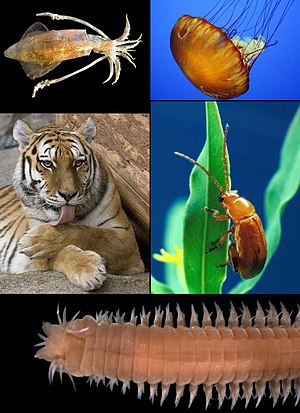Eumetazoa
| Eumetazoa | |
|---|---|
 | |
| Scientific classification | |
| Domain: | Eukaryota |
| Kingdom: | Animalia |
| Subkingdom: | Eumetazoa Buetschli, 1910 |
| Phyla | |
| |
| Synonyms | |
Eumetazoa (from
Several other extinct or obscure life forms, such as
Some phylogenists once speculated the sponges and eumetazoans evolved separately from different single-celled organisms, which would have meant that the animal kingdom does not form a clade (a complete grouping of all organisms descended from a common ancestor). However, genetic studies and some morphological characteristics, like the common presence of choanocytes, now unanimously support a common origin.[12]
Traditionally, eumetazoans are a major group of
Taxonomy
A widely accepted hypothesis, based on molecular data (mostly 18S
However, some skeptics[who?] emphasize inconsistencies in the new data. The zoologist Claus Nielsen argues in his 2001 book Animal Evolution: Interrelationships of the Living Phyla for the traditional divisions of Protostomia and Deuterostomia.[citation needed]
Evolutionary origins
It has been suggested that one type of
References
- ^ Lankester, Ray (1877). "Notes on the Embryology and classification of the Animal kingdom: comprising a revision of speculations relative to the origin and significance of the germ-layers". Quarterly Journal of Microscopical Science (N.S.), No. 68: 399–454.
- ^ Beklemishev, V. L. The basis of the comparative anatomy of the invertebrates [Основы сравнительной анатомии беспозвоночных]. 1st ed., 1944; 2nd ed., 1950; 3rd ed. (2 vols.), 1964. English translation, 1969, [1]. Akademia Nauk, Moscow, Leningrad.
- ISBN 9783642801143.
- ^ Ulrich, W. (1950). "Begriff und Einteilung der Protozoen". In Grüneberg, H. (ed.). Moderne Biologie. Festschrift zum 60. Geburtstag von Hans Nachtsheim (in German). Berlin: Peters. pp. 241–250.
- PMID 29199080.
- PMID 26621703.
- S2CID 4560353.
- .
- PMID 30373720.
- PMID 37198475.
- S2CID 43414178.
- S2CID 15282843.
- ^ "Systema Naturae 2000 Taxon: Subkingdom Eumetazoa". Archived 2009-03-22 at the Wayback Machine. Retrieved February 2, 2006
- PMID 15983372.
- PMID 15537810.
- S2CID 115443209.
External links
- Bilateria. Tree of Life web project, US National Science Foundation. 2002. 6 January 2006.
- Invertebrates and the Origin of Animal Diversity
- Evers, Christine A., Lisa Starr. Biology:Concepts and Applications. 6th ed. United States:Thomson, 2006. ISBN 0-534-46224-3.
- TRICHOPLAX ADHAERENS (PLACOZOA TYPE) St. Petersburg. 2005
- Metazoa: the Animals
- Nielsen, C. 2001. Animal Evolution: Interrelationships of the Living Phyla, 2nd edition, 563 pp. Oxford Univ. Press, Oxford. ISBN 0-19-850681-3
- Borchiellini, C. Manuel; Alivon, E.; Boury-Esnault, N.; Vacelet, J.; Le-Parco, Y. (2001). "Sponge paraphyly and the origin of Metazoa". Journal of Evolutionary Biology. 14 (1): 171–179. S2CID 25119754.
- Peterson, Kevin J.; McPeek, Mark A.; Evans, David A.D. (2005). "Tempo & mode of early animal evolution: inferences from rocks, Hox, & molecular clocks". Paleobiology. 31 (Supp 2): 36–55. S2CID 30787918.
